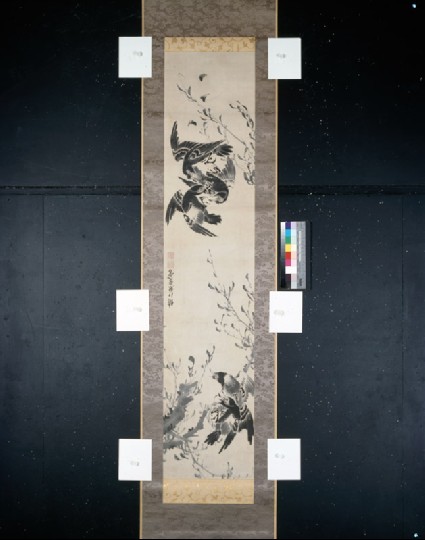Browse: 248 objects
- Reference URL
Actions
Mynah birds on a willow tree
-
Details
- Associated place
-
Asia › Japan › Kyūshū › Nagasaki prefecture › Nagasaki (possible place of creation)
- Date
- 1751 - 1764
- Artist/maker
-
Kumashiro Yūhi (1713 - 1772) (artist)Nanpin School (active 1731 - 19th century)
- Material and technique
- ink on paper
- Dimensions
-
mount 200 x 41.5 cm approx. (height x width)
painting 130.5 x 27.6 cm (height x width)
along roller 47.5 cm (length)
- Material index
- Technique index
- Object type index
- No. of items
- 1
- Credit line
- Purchased, 1966.
- Accession no.
- EA1966.4
-
Further reading
Katz, Janice, Japanese Paintings in the Ashmolean Museum, Oxford, with an introductory essay by Oliver Impey (Oxford: Ashmolean Museum, 2003), no. 13 on pp. 70-71, pp. 14 & 39, illus. p. 71
Location
-
- currently in research collection
Objects are sometimes moved to a different location. Our object location data is usually updated on a monthly basis. Contact the Jameel Study Centre if you are planning to visit the museum to see a particular object on display, or would like to arrange an appointment to see an object in our reserve collections.
Publications online
-

Japanese Paintings in the Ashmolean Museum
In this dynamic composition, Yūhi proves that he is the master of this subject matter that he has painted time and again. Two groups of mynah birds (hahachō), many with their mouths open in a cry, appear to be fighting over something, In the lower right, one bird even has the beak of another in its claw. Leaves fall off the tree as the birds thrash about.
The accomplishment of a painter like Yūhi is especially evident in the way the movement of the birds is expressed. Our eye moves from the quarrel in the upper left to the birds in the lower right. We see them from all possible angles; one seen from underneath is the most dramatic, but the heads and bodies of all of the birds twist and turn easily in space. For the feathers, a grey wash has been put down first, with a darker black painted on top of it. The branch of the willow tree has been done with a dry brush in grey tones, the darkest tone of ink being reserved for the birds.
The subject of mynah birds is also taken up by Yūhi as one panel of a pair of six-fold screens that the artist painted for the eighth head of the Owari domain, Tokugawa Munekatsu (1705-1761), in 1753 or 1754 [This is published in Chiba City Art Museum, Edo no ikoku shumi: nanpinfū dairyūkō: shinseiki, shisei shikō 80-shūnen kinen (Chiba City Art Museum, 2001), 52-3, 174-5]. Another painting of mynah birds on a plum tree with the same seals as the Ashmolean’s painting also shows one bird with its beak held by the claw of another [See Narasaki Muneshige, ‘Kumashiro Yūhi hitsu getsubai hakka zu’, Kokka 708 (March 1951), plate 5 and pages 126-31. For the same subject painted by Shen Nanpin see Tottori Prefectural Museum, Tokubetsuten-Tottori gadan no genryū o saguru: Shiseki, Ōkyo to Hijikata Tōreiten (Tottori: Tottori Prefectural Museum, 1997), 45]. This seems to have been a favourite pose of the artist.
Yūhi was a native of Nagasaki and was born into a family of Chinese language translators. Thus, when the painter Shen Nanpin sojourned in Nagasaki for two years beginning in 1731, it was natural that Yūhi met him, and became his only known Japanese pupil. It is through Yūhi that the Shen Nanpin style of realistic flower and bird painting spread, a style that claimed a great number of adherents in eighteenth- and nineteenth-century Japan including Sō Shiseki, Masuyama Sessai and others.
© 2013 University of Oxford - Ashmolean Museum

